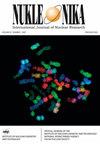Comparison of the neutronic properties of the (Th-233U)O2, (Th-233U)C, and (Th-233U)N fuels in small long-life PWR cores with 300, 400, and 500 MWth of power
IF 0.7
4区 物理与天体物理
Q4 CHEMISTRY, INORGANIC & NUCLEAR
引用次数: 0
Abstract
The neutronic characteristics of (Th-233U)O2, (Th-233U)C, and (Th-233U)N have been compared in small long-life pressurized water reactors (PWRs). Neutronic calculations were carried out at 300 MWth, 400 MWth, and 500 MWth with two cladding types: zircaloy-4 and ZIRLO (Zr low oxygen). They were performed using the Standard Reactor Analysis Code (SRAC) and JENDL-4.0 nuclide data, dividing the reactor core into three fuel zones with varying 233U enrichment levels, ranging from 3% to 9% and fluctuating by 1%, employing the PIJ module at the fuel cell level and the CITATION module at the reactor core level. In addition, 231Pa was added as burnable poison (BP). The (Th-233U)N fuel demonstrated superior criticality compared to the other fuel types, as it consistently achieves critical conditions throughout the reactor’s operating cycle with excess reactivity <1.00% dk/k for several fuel configurations at the 300 MWth and 400 MWth power levels. Moreover, the (Th-233U)N and (Th-233U)C fuels exhibited similar and flatter power density distribution patterns compared to the (Th-233U)O2 fuel. The power peaking factor (PPF) value was relatively higher for (Th-233U)O2 fuel than the other two fuels. The (Th-233U)N fuel exhibited the most negative Doppler coefficient, followed by (Th-233U)C and (Th-233U)O2 fuels. Analysis of burnup levels revealed that the (Th-233U)O2 fuel achieved significantly higher burnup than the other two fuels.功率为 300、400 和 500 MWth 的小型长寿命压水堆堆芯中 (Th-233U)O2、(Th-233U)C 和 (Th-233U)N 燃料的中子特性比较
在小型长寿命压水堆(PWR)中比较了(Th-233U)O2、(Th-233U)C和(Th-233U)N的中子特性。中子计算是在 300 MWth、400 MWth 和 500 MWth 条件下进行的,有两种包层类型:锆合金-4 和 ZIRLO(低氧锆)。研究使用了标准反应堆分析代码(SRAC)和 JENDL-4.0 核素数据,将反应堆堆芯分为三个燃料区,233U 的富集水平从 3% 到 9% 不等,波动幅度为 1%,在燃料电池层使用了 PIJ 模块,在反应堆堆芯层使用了 CITATION 模块。此外,还添加了 231Pa 作为可燃毒物 (BP)。与其他类型的燃料相比,(Th-233U)N燃料的临界状态更优越,因为在反应堆的整个运行周期中,它都能稳定地达到临界状态,在 300 MWth 和 400 MWth 功率水平下,几种燃料配置的过剩反应性均小于 1.00% dk/k。此外,与(Th-233U)O2燃料相比,(Th-233U)N和(Th-233U)C燃料表现出相似且更平缓的功率密度分布模式。(Th-233U)O2燃料的功率峰值因数(PPF)值相对高于其他两种燃料。(Th-233U)N燃料的负多普勒系数最大,其次是(Th-233U)C和(Th-233U)O2燃料。燃烧水平分析表明,(Th-233U)O2 燃料的燃烧水平明显高于其他两种燃料。
本文章由计算机程序翻译,如有差异,请以英文原文为准。
求助全文
约1分钟内获得全文
求助全文
来源期刊

Nukleonika
物理-无机化学与核化学
CiteScore
2.00
自引率
0.00%
发文量
5
审稿时长
4-8 weeks
期刊介绍:
"Nukleonika" is an international peer-reviewed, scientific journal publishing original top quality papers on fundamental, experimental, applied and theoretical aspects of nuclear sciences.
The fields of research include:
radiochemistry, radiation measurements, application of radionuclides in various branches of science and technology, chemistry of f-block elements, radiation chemistry, radiation physics, activation analysis, nuclear medicine, radiobiology, radiation safety, nuclear industrial electronics, environmental protection, radioactive wastes, nuclear technologies in material and process engineering, radioisotope diagnostic methods of engineering objects, nuclear physics, nuclear reactors and nuclear power, reactor physics, nuclear safety, fuel cycle, reactor calculations, nuclear chemical engineering, nuclear fusion, plasma physics etc.
 求助内容:
求助内容: 应助结果提醒方式:
应助结果提醒方式:


